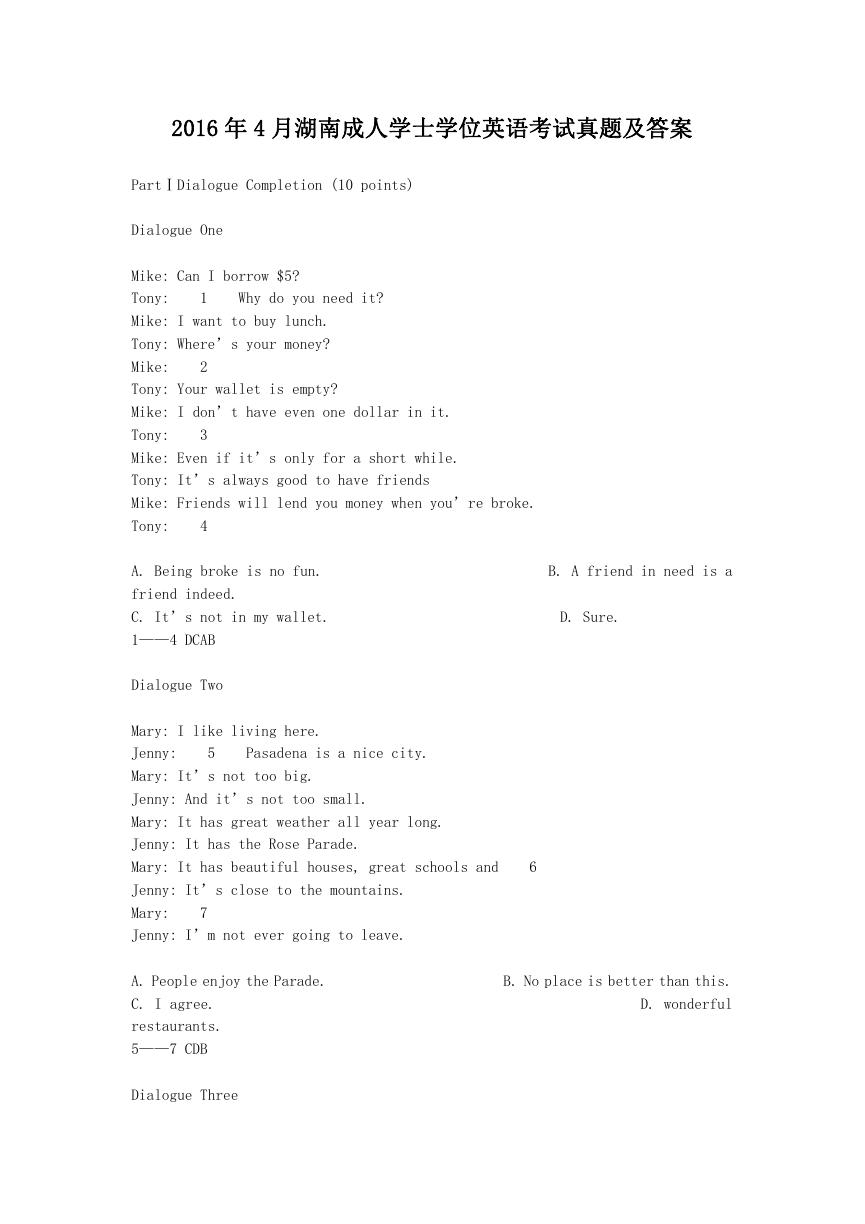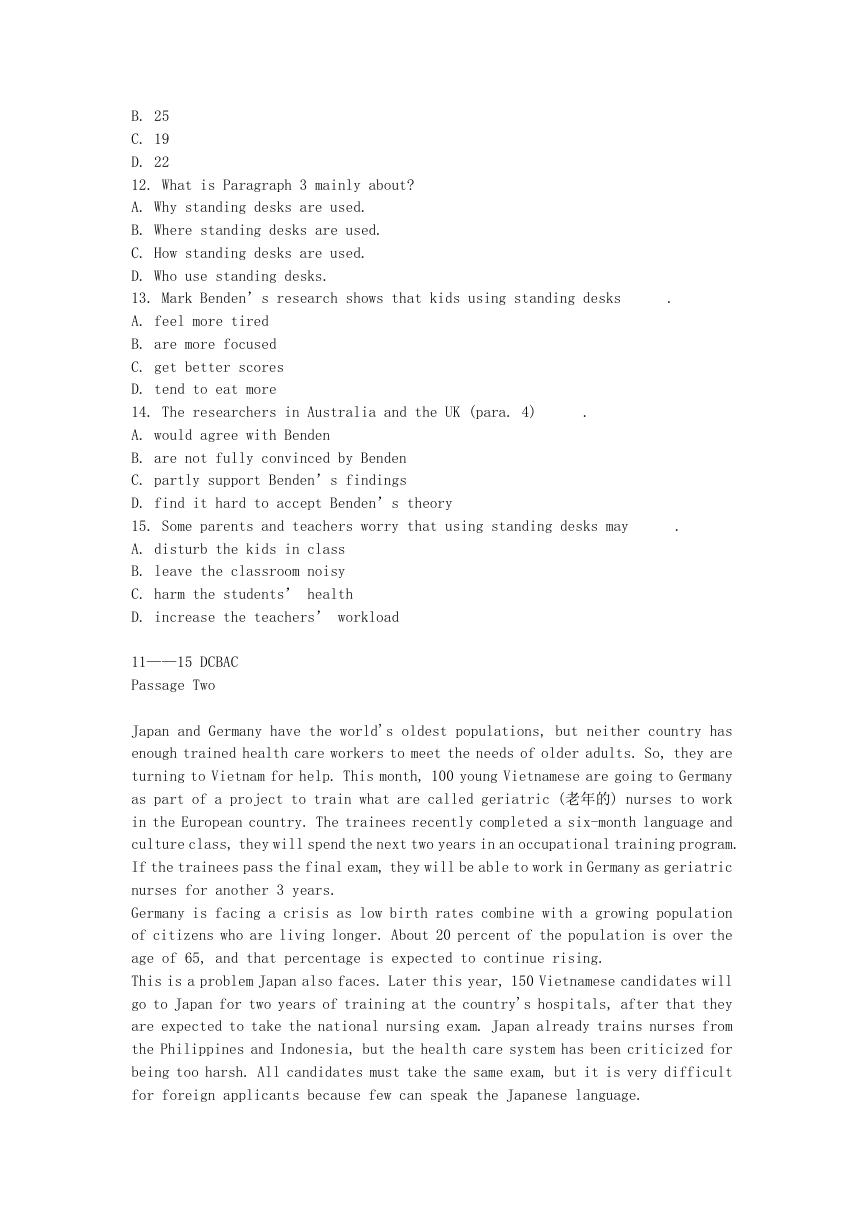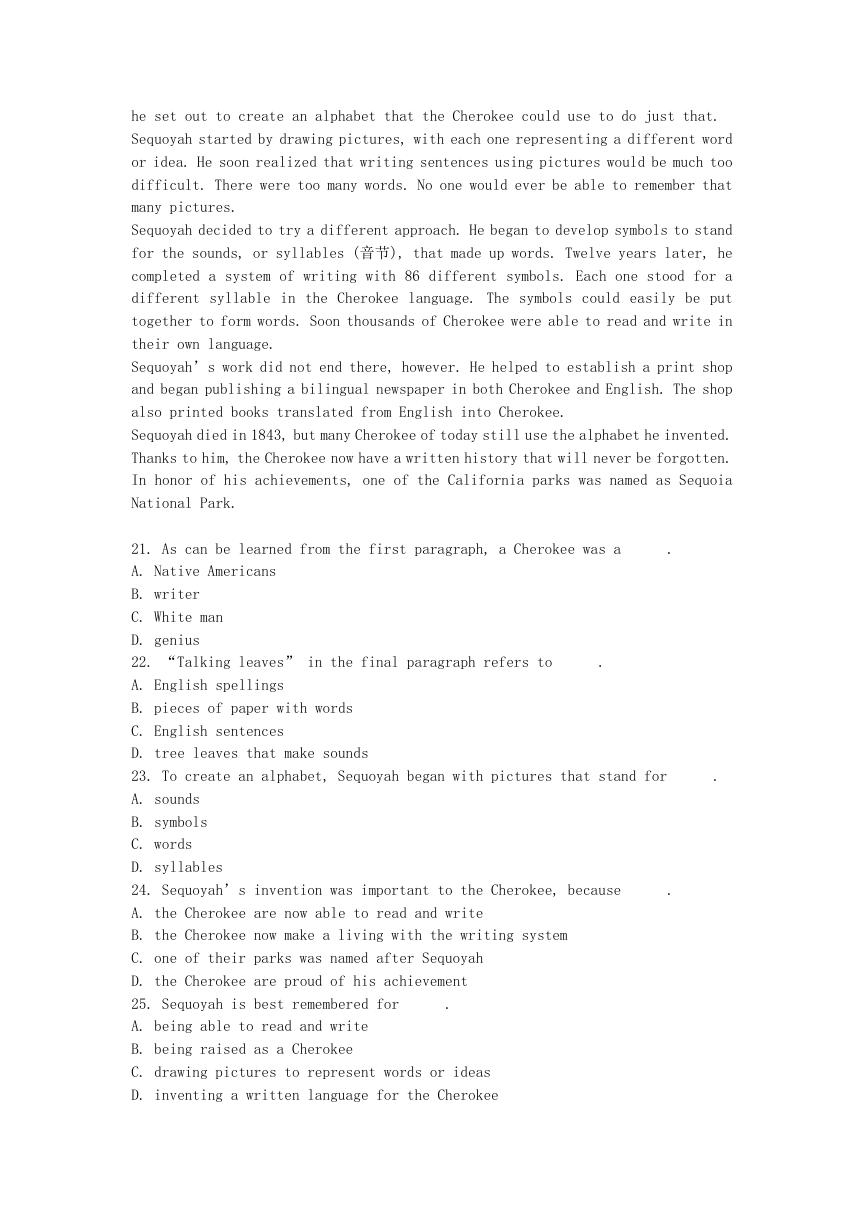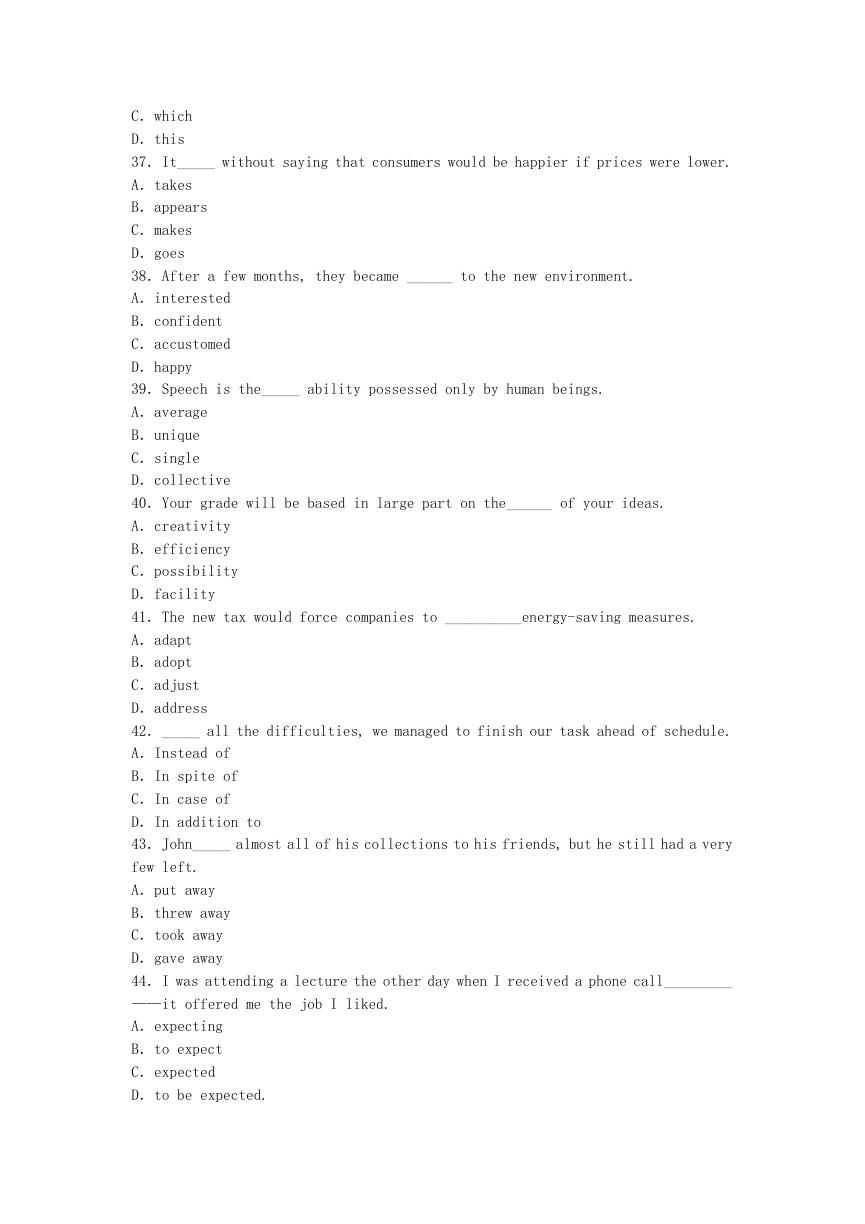2016 年 4 月湖南成人学士学位英语考试真题及答案
PartⅠDialogue Completion (10 points)
Dialogue One
1
2
Why do you need it?
Mike: Can I borrow $5?
Tony:
Mike: I want to buy lunch.
Tony: Where’s your money?
Mike:
Tony: Your wallet is empty?
Mike: I don’t have even one dollar in it.
Tony:
Mike: Even if it’s only for a short while.
Tony: It’s always good to have friends
Mike: Friends will lend you money when you’re broke.
Tony:
4
3
A. Being broke is no fun.
friend indeed.
C. It’s not in my wallet.
1——4 DCAB
Dialogue Two
B. A friend in need is a
D. Sure.
5
Pasadena is a nice city.
Mary: I like living here.
Jenny:
Mary: It’s not too big.
Jenny: And it’s not too small.
Mary: It has great weather all year long.
Jenny: It has the Rose Parade.
Mary: It has beautiful houses, great schools and
Jenny: It’s close to the mountains.
Mary:
Jenny: I’m not ever going to leave.
7
A. People enjoy the Parade.
C. I agree.
restaurants.
5——7 CDB
Dialogue Three
6
B. No place is better than this.
D. wonderful
�
John: Do you have a car?
Bill: Yes. I do.
John: Is it new?
Bill: It was new in 2008.
John: So, it’s pretty old now.
Bill: Yes, it is.
John: Do you take good care of it?
Bill: Oh, yes.
10
8
9
And my mechanic changes the oil twice a year.
A. But it still looks good.
B. What kind of car do you have?
C. I have a Honda.
D. I wash it once a week.
8——10 CAD
PartⅡReading Comprehension (40 points)
Passage One
The new year brought new desks for students at Vallecito Elementary School, in San
Rafael, California. The last three of the school’s 22 classrooms switched from
seated desks to standing desks. “It’s now the first all-standing school,” Juliet
Starrett told TFK. She started the group StandUp Kids. Her goal is to have every
U.S. public school kid using a standing desk within the next 10 years.
Starrett’s daughters—Georgia, 10, and Caroline, 7—attend Vallecito. They are
thrilled with their desks. “You feel happier, you’re less tired, and you’re more
active,” Georgia says.
Some of the desks have wheels and fidget bars. The bars let kids move in a way that
doesn’t disturb the class. Wheels allow the desks to be moved easily. The desks
also adjust to different heights. Kids take breaks by sitting on the floor.
There is the trend of designing things to make them easy and safe to use. According
to Mark Benden, director of the Texas A&M Center, standing workers are more focused
and healthier. He says his research shows that kids using standing desks are more
engaged and burn more calories (卡路里). In December, researchers in New Zealand,
Australia, and the United Kingdom released similar findings. But not everyone is
convinced standing is better than sitting. Some parents and teachers worry that
kids will get tired and that standing for long periods of time may be harmful. And
standing desks are more expensive.
Benden says both sitting and standing desks can cause problems if they are not the
proper height. “Our message should not be ‘Sit less, stand more,’” he says, “but
‘Sit less, move more.’”
11. How many classrooms in Vallecito are equipped with standing desks?
A. 3
�
B. 25
C. 19
D. 22
12. What is Paragraph 3 mainly about?
A. Why standing desks are used.
B. Where standing desks are used.
C. How standing desks are used.
D. Who use standing desks.
13. Mark Benden’s research shows that kids using standing desks
A. feel more tired
B. are more focused
C. get better scores
D. tend to eat more
14. The researchers in Australia and the UK (para. 4)
A. would agree with Benden
B. are not fully convinced by Benden
C. partly support Benden’s findings
D. find it hard to accept Benden’s theory
15. Some parents and teachers worry that using standing desks may
A. disturb the kids in class
B. leave the classroom noisy
C. harm the students’ health
D. increase the teachers’ workload
.
.
.
11——15 DCBAC
Passage Two
Japan and Germany have the world's oldest populations, but neither country has
enough trained health care workers to meet the needs of older adults. So, they are
turning to Vietnam for help. This month, 100 young Vietnamese are going to Germany
as part of a project to train what are called geriatric (老年的) nurses to work
in the European country. The trainees recently completed a six-month language and
culture class, they will spend the next two years in an occupational training program.
If the trainees pass the final exam, they will be able to work in Germany as geriatric
nurses for another 3 years.
Germany is facing a crisis as low birth rates combine with a growing population
of citizens who are living longer. About 20 percent of the population is over the
age of 65, and that percentage is expected to continue rising.
This is a problem Japan also faces. Later this year, 150 Vietnamese candidates will
go to Japan for two years of training at the country's hospitals, after that they
are expected to take the national nursing exam. Japan already trains nurses from
the Philippines and Indonesia, but the health care system has been criticized for
being too harsh. All candidates must take the same exam, but it is very difficult
for foreign applicants because few can speak the Japanese language.
�
Even with an aging population, many Japanese are opposed to foreigners working in
some industries. Critics say foreign labor could lead to higher unemployment, but
there is little opposition to foreign nurses.
In Vietnam, the situation is very different. 60 percent of the population was born
after the Vietnam war ended in 1975. There are not enough jobs for everyone who
wants one in Vietnam, but learning the nursing skills can help them find jobs
overseas.
.
in Germany before working there
16. The overseas Vietnamese nurses must complete the following EXCEPT
A. a culture course
B. a health care exam
C. a language training
D. a driving test
17. A Vietnamese youngster will spend at least
as a geriatric nurse.
A. six months
B. one and a half years
C. two and a half years
D. five years
18. It is inferred from the passage that in Japan
A. the health care system is much more strict than that in Germany
B. the majority of nurses are from Vietnam, Indonesia and the Philippines
C. the Vietnamese who pass the national exams will be trained at hospitals
D. foreigners find it hard to pass nursing exams because few can speak Japanese
19. Faced with the aging population, many Japanese
A. welcome foreign nurses working in Japan
B. oppose foreign labor working in most places
C. criticize the government for being too harsh
D. blame the government for high unemployment
20. The last paragraph indicates that
A. the Vietnamese also face the aging problem
B. over half of the Vietnamese are under the age of 45
C. sixty percent people cannot find jobs in Vietnam
D. more and more Vietnamese have found jobs abroad
.
.
.
16——20 DCDBD
Passage Three
Born around 1770 in Tennessee, Sequoyah was a Cherokee. Like other Native Americans
of that time, he could neither read nor write. He couldn’t help noticing, though,
how white people wrote to one another on sheets of paper. They often used these
“talking leaves,” as some Native Americans called them, to communicate.
Back then, the Cherokee had no way to write down words in their own language. Sequoyah
believed it was important for the Cherokee to have a system of writing. So, in 1809,
�
he set out to create an alphabet that the Cherokee could use to do just that.
Sequoyah started by drawing pictures, with each one representing a different word
or idea. He soon realized that writing sentences using pictures would be much too
difficult. There were too many words. No one would ever be able to remember that
many pictures.
Sequoyah decided to try a different approach. He began to develop symbols to stand
for the sounds, or syllables (音节), that made up words. Twelve years later, he
completed a system of writing with 86 different symbols. Each one stood for a
different syllable in the Cherokee language. The symbols could easily be put
together to form words. Soon thousands of Cherokee were able to read and write in
their own language.
Sequoyah’s work did not end there, however. He helped to establish a print shop
and began publishing a bilingual newspaper in both Cherokee and English. The shop
also printed books translated from English into Cherokee.
Sequoyah died in 1843, but many Cherokee of today still use the alphabet he invented.
Thanks to him, the Cherokee now have a written history that will never be forgotten.
In honor of his achievements, one of the California parks was named as Sequoia
National Park.
.
.
.
21. As can be learned from the first paragraph, a Cherokee was a
A. Native Americans
B. writer
C. White man
D. genius
22. “Talking leaves” in the final paragraph refers to
A. English spellings
B. pieces of paper with words
C. English sentences
D. tree leaves that make sounds
23. To create an alphabet, Sequoyah began with pictures that stand for
A. sounds
B. symbols
C. words
D. syllables
24. Sequoyah’s invention was important to the Cherokee, because
A. the Cherokee are now able to read and write
B. the Cherokee now make a living with the writing system
C. one of their parks was named after Sequoyah
D. the Cherokee are proud of his achievement
25. Sequoyah is best remembered for
A. being able to read and write
B. being raised as a Cherokee
C. drawing pictures to represent words or ideas
D. inventing a written language for the Cherokee
.
.
�
21——25 ABCAD
Passage Four
Closed Circuit Television, usually abbreviated to CCTV, is everywhere in today's
society. In fact, when we go about our everyday lives it is virtually impossible
to avoid it. If you take a bus to school, there will be a camera on it. When you
pop out to the supermarket to buy some bread, a camera will be watching you walk
around the shop. If you look up, you'll see cameras on many street corners, at bus
stops, on trains and even in some public toilets. We seem to have developed an
obsession (迷恋) with them!
In 2013, an article published in The Guardian (a British newspaper) stated that
there was 1 camera for every 11 people in Britain. There are estimated to be around
6 million CCTV cameras across Britain - now that's a lot of cameras! Thanks to our
apparent love of CCTV, Britain has been nicknamed the "surveillance state".
CCTV is a vital tool for the police and can help solve crimes - a notable example
would be the James Bulger case from 1993. CCTV images meant that the two boys who
committed the crime were caught and prosecuted. However, CCTV does not always have
all the answers. Sometimes the images aren't clear enough to identify people; often,
criminals obscure their faces to avoid being caught. Recently, some talking CCTV
cameras have been installed in the UK. These react to movement, and warn criminals
that their photo has been taken.
In my opinion, CCTV has gone too far. As a nation, we rely on it far too much. At
what point did we decide to replace police officers with technology? Many people
claim to feel safer as a result of CCTV; if more police were around I'm sure they'd
feel just as safe! Many schools across Britain have installed CCTV - in classrooms,
toilets and changing rooms. They say it helps to prevent bullying - but surely
something else could be done instead?
26. According to Paragraph 1, CCTV________
A. can be easily avoided
B. is widely used in society
C. can be bought in supermarket
D. makes public streets much safer
27. The word “surveillance” (Para.2) probably means “________”.
A. monitor
B. safety
C. crime
D. public
28. Why does the author mention the James Bulger case?
A. It is a well-known case in the UK.
B. It proves the importance of CCTV.
C. It is a lesson for the British police.
D. It warns of the danger from boy criminals.
�
29. According to the passage, the talking CCTV cameras__________.
A. do not have clear images
B. help find hidden criminals
C. can identify dim faces
D. give warnings to criminals
30. What is the author’s attitude towards CCTV?
A. Positive
B. Negative
C. Objective
D. Unclear
26——30 BABDB
PartⅢ Vocabulary and Structure (10 points)
31.Retail sales in city and rural areas rose 57.8% and 46.8%__________last year.
A.expectedly
B.respectively
C.separately
D.accordingly
32.Had he received six more votes in the last election, he _____ our chairman now.
A.must be
B.would have been
C.shall be
D.would be
33.Finding out about these universities has become easy for anyone with Internet
_____
A.entrance
B.admission
C.access
D.entry
34.Blacks and American Indians___ less than 10% of students in the top 10 business
college.
A.make up
B.take up
C.reach out
D.turn out
35.No one knows for sure _____the world would be like in 50 years.
A.how
B.that
C.which
D.what
36.The only thing____ really matters to me is how soon we can return home.
A.what
B.that
�
C.which
D.this
37.It_____ without saying that consumers would be happier if prices were lower.
A.takes
B.appears
C.makes
D.goes
38.After a few months, they became ______ to the new environment.
A.interested
B.confident
C.accustomed
D.happy
39.Speech is the_____ ability possessed only by human beings.
A.average
B.unique
C.single
D.collective
40.Your grade will be based in large part on the______ of your ideas.
A.creativity
B.efficiency
C.possibility
D.facility
41.The new tax would force companies to __________energy-saving measures.
A.adapt
B.adopt
C.adjust
D.address
42._____ all the difficulties, we managed to finish our task ahead of schedule.
A.Instead of
B.In spite of
C.In case of
D.In addition to
43.John_____ almost all of his collections to his friends, but he still had a very
few left.
A.put away
B.threw away
C.took away
D.gave away
44.I was attending a lecture the other day when I received a phone call_________
——it offered me the job I liked.
A.expecting
B.to expect
C.expected
D.to be expected.
�
















 2023年江西萍乡中考道德与法治真题及答案.doc
2023年江西萍乡中考道德与法治真题及答案.doc 2012年重庆南川中考生物真题及答案.doc
2012年重庆南川中考生物真题及答案.doc 2013年江西师范大学地理学综合及文艺理论基础考研真题.doc
2013年江西师范大学地理学综合及文艺理论基础考研真题.doc 2020年四川甘孜小升初语文真题及答案I卷.doc
2020年四川甘孜小升初语文真题及答案I卷.doc 2020年注册岩土工程师专业基础考试真题及答案.doc
2020年注册岩土工程师专业基础考试真题及答案.doc 2023-2024学年福建省厦门市九年级上学期数学月考试题及答案.doc
2023-2024学年福建省厦门市九年级上学期数学月考试题及答案.doc 2021-2022学年辽宁省沈阳市大东区九年级上学期语文期末试题及答案.doc
2021-2022学年辽宁省沈阳市大东区九年级上学期语文期末试题及答案.doc 2022-2023学年北京东城区初三第一学期物理期末试卷及答案.doc
2022-2023学年北京东城区初三第一学期物理期末试卷及答案.doc 2018上半年江西教师资格初中地理学科知识与教学能力真题及答案.doc
2018上半年江西教师资格初中地理学科知识与教学能力真题及答案.doc 2012年河北国家公务员申论考试真题及答案-省级.doc
2012年河北国家公务员申论考试真题及答案-省级.doc 2020-2021学年江苏省扬州市江都区邵樊片九年级上学期数学第一次质量检测试题及答案.doc
2020-2021学年江苏省扬州市江都区邵樊片九年级上学期数学第一次质量检测试题及答案.doc 2022下半年黑龙江教师资格证中学综合素质真题及答案.doc
2022下半年黑龙江教师资格证中学综合素质真题及答案.doc